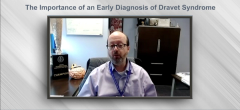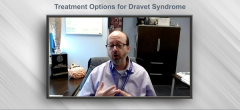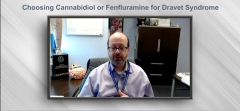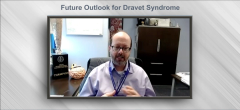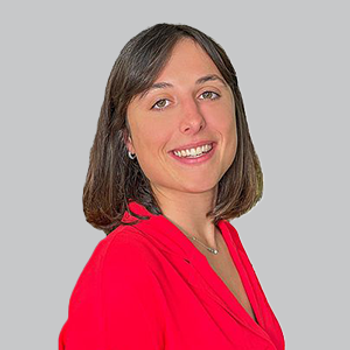
Future Outlook for Dravet Syndrome
M. Scott Perry, MD, shares his excitement for future developments and treatments for Dravet syndrome.
M. Scott Perry, MD: The future for Dravet syndrome is really bright, and it’s bright not just for Dravet syndrome, but as a genetic-based epilepsy, it is bright because it is forging the way for other genetic epilepsies, in my opinion. Dravet syndrome is a disease of haploinsufficiency. We all walk around with 2 versions of the SCN1A [gene], and the problem with Dravet syndrome is 1 of them doesn’t work very well, which leaves us with about 50% of the SCN1A protein in those cases. That’s not enough, and thus you have Dravet syndrome.
There are some exciting therapies out there that are really trying to get at the genetic etiology and correct that problem. One is a trial of antisense oligonucleotides [ASOs], which is being investigated by a company called Stoke [Therapeutics]. The SCN1A messenger RNA may come with basically information called a decay exon. If that decay exon is there, even if it’s a good copy of SCN1A, it will be destroyed, and the protein will not be made. The concept here is that by giving a patient with Dravet this antisense oligonucleotide through a spinal tap, the antisense oligonucleotide is a piece of genetic material, basically, that binds to that decay exon and turns it off, and if it turns it off, then this version can get through and be made all the way to a healthy protein.
So when you only have 1 copy that is working, and some of that working copy gets destroyed just naturally, if you can save it and keep it from getting destroyed, you’ll elevate the amount of appropriately functioning sodium channel, or SCN1A. That’s how that concept works. They’ve shown in a mouse model that it works. It reduced significantly the rate of sudden unexpected death in mice with Dravet syndrome that were given this treatment. They’ve also shown some early evidence that there are decreased seizures in those mice models as well.
Now, a second approach is one using viral vector therapy. This uses an attenuated adenoviral vector, which is somewhat of a similar approach in that it is, again, a piece of genetic material being injected, in this case intraventricularly, directly into the brain, delivering this payload that will increase the amount of healthy SCN1A. The difference here is that’s more of a DNA approach versus a messenger RNA approach.
Key differences between the two are potentially ASO therapies may need to be given multiple times to be effective because they get broken down over time and you may need to dose it again, whereas a viral therapy is thought to be a one-time thing. Obviously, there’s a difference between an intraventricular injection and a spinal tap, so there are some differences in how it’s administered. Potentially there are some safety differences that we won’t know until those trials are done.
The ASO therapy is in investigation now. Those trials are open and being done. The viral vector therapy is in planning. Hopefully in the coming year that will be done. Along with these 2 approaches, there are some what we call natural history studies. They’re not necessarily natural history studies, but they’re trying to see what the course of this condition is because Dravet syndrome—we’ve talked a lot about seizures, but it’s more than just seizures.
It is cognitive delays. It is problems with sleep. It is problems with behavior. These children will develop difficulties walking as they get older. There are a variety of comorbidities. What we don’t understand is how much of that is inherent to the actual mutation itself and the SCN1A channel, how much of it is the seizures themselves, and if we got control of the seizures, how would that change the comorbidities? And how much of is it the ways we treat the condition to start with?
These natural history studies are basically following children over time to understand how all of these comorbidities relate to each other so that when we do look at these things like ASO and viral vector therapy, which are disease modifying therapies, we can show that the treatment actually modifies the disease. It doesn’t just change seizure frequency but modifies what happens. The endgame hope is that not only can we find a treatment that stops the progression of the disorder, makes the seizures get better, maybe reverses some of the problems, but what if we had a way to treat this before the condition really even manifests?
If you had newborn screening, and you knew a person carried an SCN1A pathogenic variant, and they started to show the early signs of this condition with seizures, could you treat so early on that you could keep it from progressing at all? That’s really the ultimate goal, to prevent it from happening at all. I honestly think that’s where we’re headed. I do think the future is really bright, and if we can do that for this condition, there are multiple other epilepsies that have genetic pathologies that we may be able to correct as well.
For a community neurologist out there, the advice I give is first of all, just be aware of it. I cannot stress how important that is. Be aware of the condition. Look for those kids who come in with what seems like an atypical febrile seizure. If it’s long, especially if it’s hemiclonic, if they’re seizing every single time they have a fever, be aware of it. Make use of these programs that allow for free genetic testing, but also understand that genetic testing comes with results.
When you get those results, sometimes they may be hard to interpret because there may be multiple genes that have variance, and not all variance causes disease. Understand that having an SCN1A variant doesn’t necessarily equal having Dravet syndrome, and having Dravet syndrome doesn’t necessarily equal having an SCN1A variant. Just be aware of that. There are multiple centers across the country that specialize in not only genetic epilepsy, like mine, but specialize particularly in Dravet syndrome.
You can go to the Dravet Syndrome Foundation, where they have a list of sites that are very familiar with this condition. We’d be happy to help you out if you have any questions, you can always contact any of us. Many of us serve on the scientific advisory board or the medical advisory board and are happy to help other physicians care for this. Really, it’s making the diagnosis, being aware of it, and just getting the kid to the right types of treatments early on. That’s probably the best advice I can give to community neurologists.
Newsletter
Keep your finger on the pulse of neurology—subscribe to NeurologyLive for expert interviews, new data, and breakthrough treatment updates.

